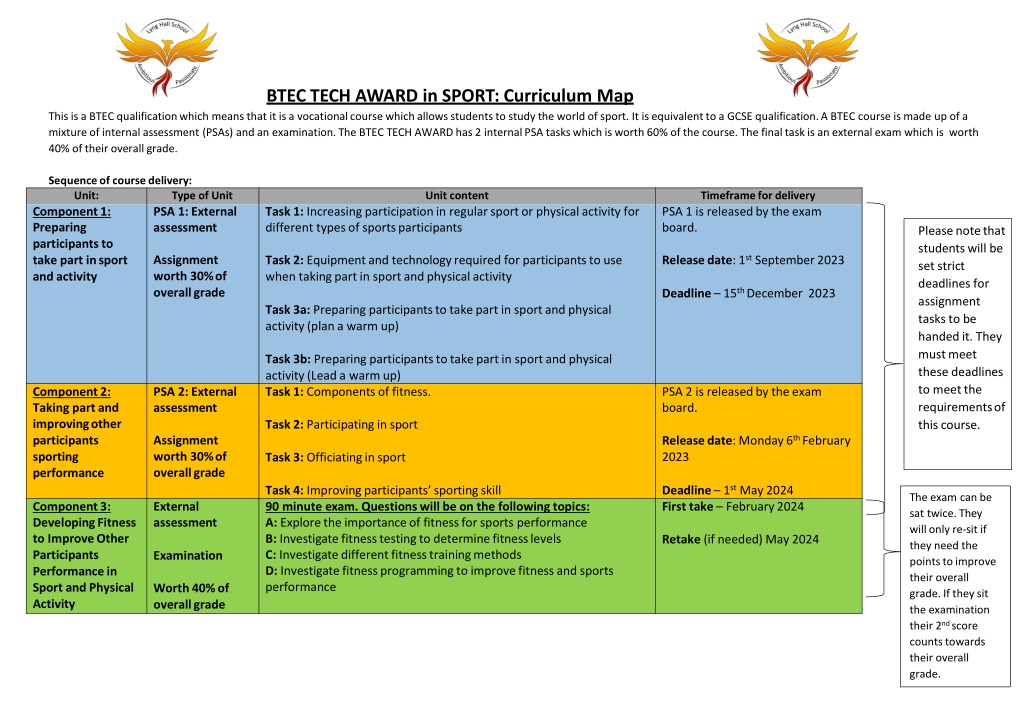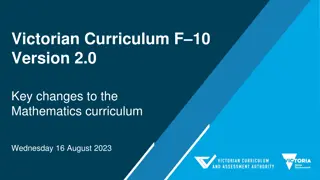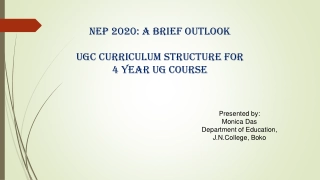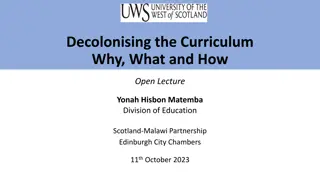BTEC TECH AWARD in SPORT: Curriculum Overview
This BTEC TECH AWARD in SPORT curriculum map outlines the structure and assessment components of the qualification, including tasks related to increasing participation in sports, using equipment and technology, planning and leading warm-ups, understanding fitness components, improving sporting skills, and more. Students will be assessed through a combination of internal assignments and an external exam, covering topics such as fitness importance, training methods, officiating, and performance enhancement. The course aims to provide vocational training in the field of sports and physical activity, equivalent to a GCSE qualification.
Download Presentation
Please find below an Image/Link to download the presentation.
The content on the website is provided AS IS for your information and personal use only. It may not be sold, licensed, or shared on other websites without obtaining consent from the author. Download presentation by click this link. If you encounter any issues during the download, it is possible that the publisher has removed the file from their server.
Presentation Transcript
BTEC TECH AWARD in SPORT: Curriculum Map This is a BTEC qualification which means that it is a vocational course which allows students to study the world of sport. It is equivalent to a GCSE qualification. A BTEC course is made up of a mixture of internal assessment (PSAs) and an examination. The BTEC TECH AWARD has 2 internal PSA tasks which is worth 60% of the course. The final task is an external exam which is worth 40% of their overallgrade. Sequence of coursedelivery: Unit: Type of Unit PSA 1:External assessment Unit content Timeframe for delivery PSA 1 is released by theexam board. Component 1: Preparing participants to take part insport andactivity Task 1: Increasing participation in regular sport or physical activity for different types of sportsparticipants Please notethat students will be set strict deadlines for assignment tasks to be handed it. They must meet these deadlines to meet the requirementsof thiscourse. Release date: 1stSeptember 2023 Assignment worth 30%of overallgrade Task 2: Equipment and technology required for participants to use when taking part in sport and physicalactivity Deadline 15thDecember 2023 Task 3a: Preparing participants to take part in sport and physical activity (plan a warm up) Task 3b: Preparing participants to take part in sport and physical activity (Lead a warm up) Task 1: Components of fitness. Component2: Taking part and improvingother participants sporting performance PSA 2:External assessment PSA 2 is released by theexam board. Task 2: Participating in sport Release date: Monday 6th February 2023 Assignment worth 30%of overallgrade Task 3: Officiating insport Deadline 1st May 2024 First take February2024 Task 4: Improving participants sporting skill 90 minute exam. Questions will be on the following topics: A: Explore the importance of fitness for sports performance B: Investigate fitness testing to determine fitnesslevels C: Investigate different fitness training methods D: Investigate fitness programming to improve fitness and sports performance The exam can be sat twice. They will only re-sit if they need the points toimprove their overall grade. If they sit the examination their 2nd score counts towards their overall grade. Component3: DevelopingFitness to Improve Other Participants Performance in Sport and Physical Activity External assessment Retake (if needed) May2024 Examination Worth 40%of overallgrade
Key knowledge & skills to be mastered by students Year 10 Component 1: Preparing participants to take part in sport and activity PSA 1 -30% of overallgrade Component 2: Taking part and improving other participants sporting performance PSA 2 -30% of overallgrade Task2: Participatingin sport Task1: Increasing participation in regular sport or physical activity for different types of sports participants Task2: Equipment and technology required for participants to use when taking part in sportand physicalactivity Task3a: Preparing participants to take part insport and physical activity (plan a warmup) Task3b: Preparing participants to take part insport and physical activity (Lead a warmup). Task1: Componentsof fitness. Task 3:Officiating in sport Task 4: Improving participants sportingskill Topic title How can we successfully increase participationin physicalactivity for chosen participants? Howcan technology aid individualsduring participationin physicalactivity? How can the chosen participant safely prepare forthe chosenphysical activity? How can I successfullylead the warm up designed forthe chosen participant? Why are components of fitnessimportant duringsporting performances? How can Ihelp young people understandthe skillsand strategies required in the chosenactivity? How can Ihelp young people to have a better understandingof the roles of the officials andthe rules a chosen activity? How can I successfully plan and lead a tournamentfor young people to demonstrate their skills in the chosen activity? Keyquestions For a chosen scenario fromthe exam board students must write an account of: For a chosen scenario fromthe exam board students must write an account of: For a chosen scenario fromthe exam board students must write an account of: Video evidenceof the warmupto include: Produce awritten responsewhich includes an accountof: Video evidenceof performance ina chosen sport to include: Producea presentation (PowerPoint or physical demonstrationn ) of: Produce awritten responsewhich includes: Keyknowledge andconcepts 1. practical evidence including demonstrations and audio of students delivering a warm-up to a group of participants. 1. A plan for a drills and conditioned practices for one sporting skill of student schoice. 1.How the components of fitness will be used during participationin the teamsport 1.At least three sports skills being performed in isolatedpractices 1. Justification of their chosen physical activities and explain how they meet the needs of the selected participant 1. Justificationof their choices of the different types of sports clothing and equipment required for the participantto 1. A warm-up plan thatincludes a pulse raiser, mobiliser and preparation stretches for the selected participant to prepare themto 1.The different roles and responsibilities of officials in the selectedsport 2.Sports skills and strategies beingperformed in a competitive situation. Providevideo evidenceof: 2.The impactof each of these components of fitnesson 2.rules and regulations around:
2. The characteristicsof the type of provision inthe participant slocal area and the advantages and disadvantages of this provisionfor the chosen physicalactivities and the needsof theselected participant take part inthe chosenactivity. take part in the chosenphysical activity 2. An account to justify the choice of activities in each component of the warm-up related to the needs of the participant, the responses of the cardiorespiratory system and musculoskeletal system and the chosen physical activity. 2. pulse raiser, mobiliserand preparation stretches. performancein the teamsport. a) the numberof players b)how players can score when taking part inthe selected sport 1. Students demonstrating that they areable to deliver demonstrations of thetechniques to the participants and support them as they take part in the planneddrills andconditioned practices. 2.Justificationthe use of the different types of technology available for the individual to participate in the chosen activity. 3.Practical evidence including audio of students supporting participants to take part in a warm-up for the chosen physical activity using key teaching pointsto support good practice. 3. Actions the officials wouldbe expected to take to ensure the rules associated with: a)the numberof players b)scoring is adhered towhen taking part inthe selected sport. 3.The benefits and limitationsof using this technology for the individual to participate in the chosen activity 3.The potential barriers to participation in the chosen physical activities for the selected participant 4.The methodsto overcome these barriers to participation for this selected participant and the chosen physical activities. Justify Explain Apply Assess Recommend Justify Review Plan Justify Assess Review Lead Instructions Evaluate Review Describe Explain Analyse Performance Skills Strategies Tactics Describe Explain Demonstrate Lead Demonstrate Plan Review Skills (Command words) Folder work Consolidation tasks Exit tickets Folder work Consolidation tasks Exit tickets Folder work Consolidation tasks Exit tickets Folder work Consolidation tasks Exit tickets Videoevidence Folder work Consolidation tasks Exit tickets Folder work Consolidation tasks Exit tickets Videoevidence Folder work Consolidation tasks Exit tickets Videoevidence Folder work Consolidation tasks Exit tickets Videoevidence Assessment& Educational Visit Opportunities
Key knowledge & skills to be mastered by students Year11 Component 3: Developing Fitness to Improve Other Participants Performance in Sport and Physical Activity A: Explorethe importance of fitness for sports performance What isthe importance of fitness for successful participationin sport? A: Explorethe importance of fitness for sports performance What are the principles of trainingand how they canbe applied to training programmes? Thebasic principlesof training: A: Explorethe importance of fitness for sports performance What is exercise intensityand how it canbe measured or worked out.? B Investigatefitness testing todetermine fitness levels B Investigatefitness testing todetermine fitness levels B Investigate fitness testing todetermine fitness levels B Investigatefitness testing todetermine fitness levels Topictitle What isthe importance of fitness testing and requirements for administrationof each fitnesstest? What fitnesstests are appropriateto test foreach component of physicalfitness? What fitness testsare appropriate to test for each componentof skill relatedfitness? How do I use normativedata tables to interpret fitness test results? Keyquestions Types ofsports requiring specific componentsof fitness: o aerobic endurance omuscular endurance omuscular strength o speed o flexibility o body composition o power o agility o reactiontime o balance o coordination Exercise intensityand targetzones: Reasons forfitness testing: o baseline data o can designtraining programmes o see if training programmesare working o providegoal settingaims. Aerobic endurance: o multi-stage fitness test o Yo-Yo test o Harvard steptest o12-minuteCooper run or swim. Agility: oIllinois agilityrun test o T Test Comparisonto normative published data Keyknowledge andconcepts Aalyse andevaluate test results. (FITT): o frequency o intensity o time o type howan individual will train Intensity: o measureheart rate (HR) o HRintensity to fitness training methods. Balance: o stork standtest o Y balancetest. Recommendations for improvements to fitness performer based on test results. Muscular endurance: oone- minute press-up o one-minutesit-up o timed planktest. Coordination: oAlternate-Hand Wall-Tosstest o stick flip coordinationtest. Pre-testprocedures: o calibrationof equipment o informedconsent o Physical Activity Readiness Questionnaire o pre fitnesstest check. Additional principlesof training: oprogressive overload o specificity o individual differences o adaptation o reversibility o variation Target zones and training thresholds: o calculate trainingzones o apply HRmax to training o aerobic trainingzone o anaerobic trainingzone. Flexibility: o sit and reachtest o calf muscle flexibilitytest o shoulder flexibility test. Power: o vertical jumptest o standing long/broad jump oMargaria-Kalamen power test Speed: o30 metresprint test Knowledge of publishedstandard Reaction time: oruler drop test
o rest and recovery The Borg(6 20) Rating of Perceived Exertion(RPE) Scale o RPE x 10= Heart Rate(HR). test methodsand equipment. o 30 metreflying sprint. o Online reactiontime test (reactiontest timer) Accurate measurementand recording of test results and basic processing of test results for interpretation Muscular strength: o gripdynamometer o 1 RepMax. Bodycomposition: oBody MassIndex (BMI) oBioelectrical ImpedanceAnalysis (BIA) o waist to hip ratio. Therelationship between RPE and heart rate where: RPE x10 = HR(bpm). Ability to safely select appropriate test(s) for given purposes, situations and/orparticipants. Reliability oftest: o consistency of results o factors affecting reliability. Validity of results. Practicality: o cost o time taken toset up and dotest o time takento analysedata o numberof participants Skills (Command words) Explain Describe Compare Evaluate Folderwork Consolidation tasks Exit tickets Explain Describe Link Explain Describe Link Work out Folderwork Consolidation tasks Exit tickets Explain Describe Compare Explain Describe Compare Test Folder work Consolidationtasks Exit tickets Examquestions Explain Describe Compare Test Folder work Consolidationtasks Exit tickets Examquestions Analyse Compare Folderwork Consolidation tasks Exit tickets Folder work Consolidationtasks Exit tickets Examquestions Folder work Consolidationtasks Exit tickets Examquestions Assessment& EducationalVisit Opportunities
Key knowledge & skills to be mastered by students Year11 Component 3:Developing Fitness to Improve Other Participants Performance in Sport and Physical Activity C: Investigate differentfitness training methods C: Investigate differentfitness training methods C: Investigate differentfitness training methods C: Investigate different fitness trainingmethods C: Investigate different fitness trainingmethods D: Investigatefitness programming to improve fitnessand sportsperformance D: Investigatefitness programming to improve fitnessand sportsperformance Topictitle What are the requirements for eachtraining method? What are the fitness training methods for physical componentsof fitness? What are the fitness training methods for skill-related componentsof fitness? What are the additional requirements for each of thefitness trainingmethods? How doestraining methods affect the different body systems, which can lead toadaptations to improvespecific components of fitness? How canpersonal information be used to aid trainingfitness programmedesign? How can motivational techniques be used for fitness programming Keyquestions How is fitness programmedesign important? What is the provision fortaking part in fitness trainingmethods? Carryingout fitnesstraining safely and effectivelyas part of a training programme. Aerobic endurance: ocontinuous training o Fartlek training o interval training ocircuit training Agility: o Speed Agility and Quickness training(SAQ) Advantages and disadvantages: Aerobic endurance training: o adaptations tothe cardiovascularand respiratorysystems o cardiac hypertrophy o decreased resting heart rate o increased strength of respiratory muscles o capillarisation aroundalveoli. Personal information: Definition of motivation Keyknowledge andconcepts oAims details of what they wouldlike to achieve for the selected sport. o number ofpeople that can takepart o cost ofequipment o ease of set up, o access to venue/locationof training o risk of injury tothe performer if performed incorrectly, o effectivenessof training Types ofmotivation: o intrinsic o extrinsic. Power: o plyometrics Principles of setting goals to increaseand direct motivation. oObjectives how they intend to meet their aims using an appropriate component of fitness and method of training Warm-up prior to taking part in the fitness trainingmethod pulseraiser, mobility and stretch;reduce the risk of injury, prepare the body for exercise Balance: o use of specific training exercises that require balancing on a reduced size base ofsupport. Flexibility: o static active o staticpassive oProprioceptive Neuromuscular Facilitation (PNF) Personal goals specific, measurable, achievable, realistic, time-related, exciting, recorded (SMARTER): o short-termgoals o long-termgoals). Flexibilitytraining: o adaptations tothe muscular and skeletal systems o increased rangeof movement at ajoint o increased flexibility ofligament and tendons oLifestyle and physicalactivity history Muscular endurance: o freeweights and fixed resistance machines Coordination:o use of specific training exercises using two or more body parts together. Provision fortaking part in fitness trainingmethods oAttitudes, themind and personal motivation for training. Influence ofgoal setting on motivation: Cool down after taking part in the fitness training method o Public provision advantages and disadvantages.
gradually lower pulse and breathing rate to restinglevels; remove lactic acid; stretch to help return muscles to pre- exerciselength. o circuittraining o Private provision advantagesand disadvantages. oVoluntary provision advantagesand disadvantages o increasedmuscle length. Fitness programme design o providedirection for behaviour o maintain focuson the task in hand. Reaction time: o use ofspecific training exercises to practise quick responses to an external stimulus. Muscular strength training: o freeweights and fixed resistance machines Muscularendurance training: o adaptations tothe muscularsystem ocapillarisation around muscle tissue increasedmuscle tone. oUse personal information to aid trainingprogramme design. Benefits of motivation onthe sportsperformer: o increase participation o maintaintraining and intensity o increasedfitness o improved performance oSelection of appropriate training method/activity for improving/maintaining the selected components of physical and/or skill- related fitness. Speed: oacceleration sprints o interval training oresistance drills Linking each fitnesstraining method to the associated component of fitness. Muscular strength and powertraining: o adaptations tothe muscular and skeletalsystems o muscle hypertrophy o increasedtendon and ligament strength o increasedbone density. oApplication of the FITT principles and additional principlesof training Application of the basic (FITT) and additional principles of training toeach fitness training method Application of appropriate training intensities to fitnesstraining methods. Speedtraining: o adaptations tothe muscularsystem o increased tolerance tolactic acid. Skills(Command words) Explain Describe Compare Evaluate Folderwork Consolidation tasks Exit tickets Explain Describe Link Explain Describe Link Explain Describe Compare Evaluate Folder work Consolidationtasks Exit tickets Examquestions Explain Describe Compare Test Folder work Consolidationtasks Exit tickets Examquestions Explain Describe Apply Describe Apply Analyse Folderwork Consolidation tasks Exit tickets Folderwork Consolidation tasks Exit tickets Folder work Consolidationtasks Exit tickets Examquestions Folder work Consolidationtasks Exit tickets Examquestions Assessment & EducationalVisit Opportunities

















































